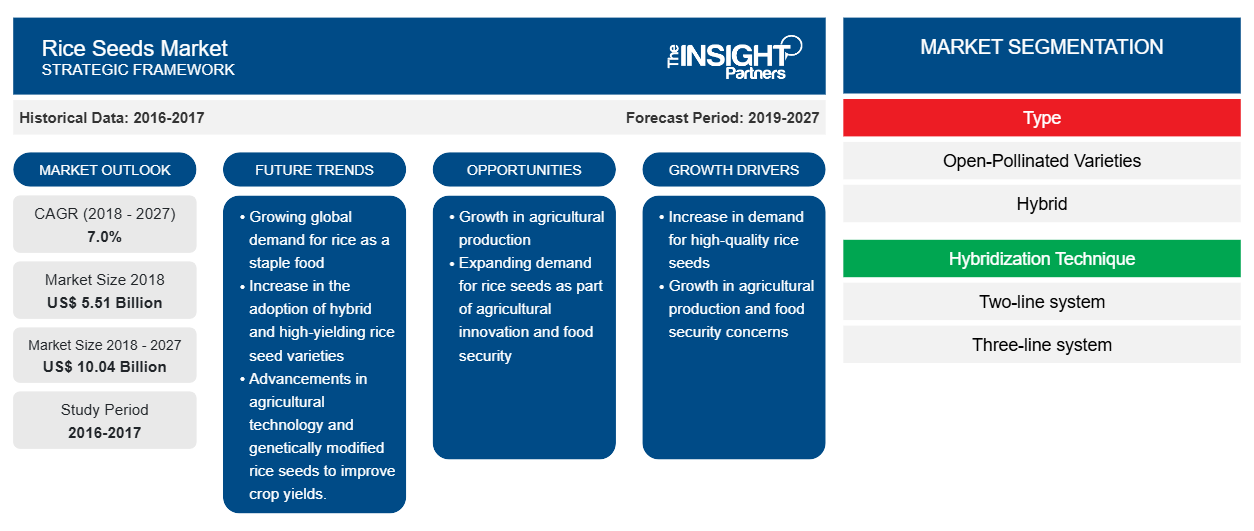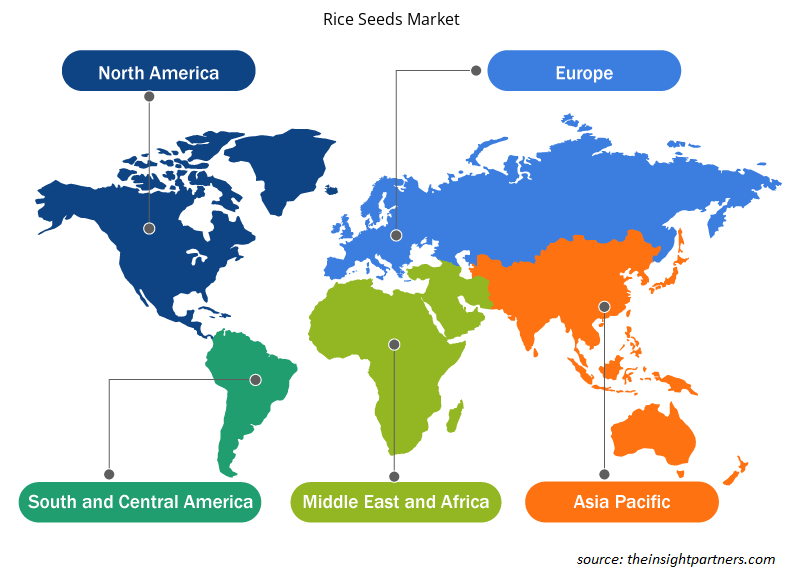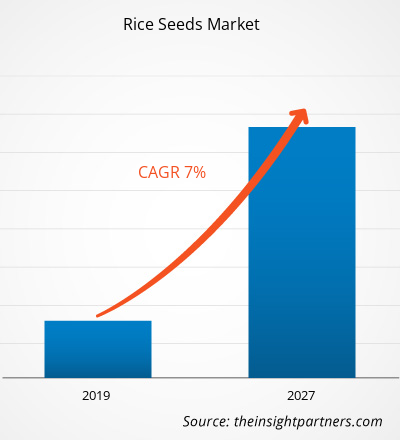The rice seeds market was valued at US$ 5,506.8 million in 2018 and is projected to reach US$ 10,036.0 million by 2027; it is expected to grow at a CAGR of 7.0% from 2019 to 2027.
Rice is a staple food in many major countries, especially in the Asia Pacific region. A rice seed, also known as paddy, is a whole rice seed, and one grain of paddy includes one rice kernel. It is an Oryza glaberrima or L. Oryza sativa seed. Further, rice seeds are used as bioreactors to produce human medications such as peptides or therapeutic proteins.The rice seeds market in Asia Pacific is expected to grow at the highest CAGR during the forecast period. The growth of the market in this region is mainly attributed to the by high population density, which is constantly growing, especially in countries such as India and China. In addition to this, around one fourth of the population residing in Asian countries falls in the poor category. These countries are expected to drive the rice consumption in the Asia Pacific countries. However, countries such as Japan and South Korea, where income is quite high, the per capita rice consumption has started declining. The constantly increasing population and shortage of cultivation area are two of the major issues that need to be addressed in the global rice seeds market. There is a strong need to increase productivity of rice cultivation to meet the growing need across the Asia Pacific region.
Customize This Report To Suit Your Requirement
You will get customization on any report - free of charge - including parts of this report, or country-level analysis, Excel Data pack, as well as avail great offers and discounts for start-ups & universities
Rice Seeds Market: Strategic Insights

- Get Top Key Market Trends of this report.This FREE sample will include data analysis, ranging from market trends to estimates and forecasts.
You will get customization on any report - free of charge - including parts of this report, or country-level analysis, Excel Data pack, as well as avail great offers and discounts for start-ups & universities
Rice Seeds Market: Strategic Insights

- Get Top Key Market Trends of this report.This FREE sample will include data analysis, ranging from market trends to estimates and forecasts.
Market Insights
Increasing Adoption Of Hybrid Seeds For High Productivity Is Expected to Fuel Rice seeds Market Growth
With increasing world population, the demand for rice to fulfill the increasing food consumption is anticipated to rise in the coming years. However, due to the availability of limited water and land resources, the increase in rice production poses a challenge for farmers. The only solution to address this issue is to increase the productivity of rice seeds. In the past few years, the rice productivity is either stagnated or declined in some regions of the world, mainly due to marginal improvements in the potential of rice yield. The development of hybrid seeds offer a solution for countries to enhance rice productivity and to achieve self-sufficiency in rice production. The increasing technological advancements in the field of molecular biology, biotechnology, and genomics have led to substantial improvements in hybrid rice breeding. In addition to this, the ongoing research and development investments and rising trend of public-private partnership (PPP) in the field of hybrid rice seed production have further led to increased adoption hybrid seeds especially among the commercial farmers. All these factors are anticipated to drive the demand for hybrid seeds during the forecast period.
Type Insights
Based on type, the rice seeds market is bifurcated into open pollinated variety and hybrid. Open Pollinated Variety (OPV) of rice seeds are a result of natural pollination of parent plant. The pollination methods in this category include self-pollination and pollination by insects, birds, and other natural means. Unlike hybrid seeds, these seeds produce plants that are identical to the parent plants and known as standard varieties in some cases. The choice of OPV depends on the requirements of a grower. OPVs, on multiplication retain the same characteristics, if maintained and produced efficiently. OPV rice seeds show more genetically diverse characteristics as they adapt slowly based on the growing conditions and climate of an area. Commercial growers prefer hybrid seeds over OPV for high yield and certain desired characteristics. While hybrid seeds offer some benefits over OPV, OPVs help in conserving the genetic diversity of plants. The increasing demand for naturally grown rice and other food products globally is anticipated to drive the market for OPV in the coming years.
Hybridization Technique Insights
Based on hybridization technique, the rice seeds market is segmented into two-line system and three line system. The two line system segment accounted for the largest market share in 2018. Some of the advantages of two line hybrids include no requirement of maintainer lines, broad parental choice for developing heterotic hybrids, and no negative effects from the sterile cytoplasm. The overall two-line seed production does not differ much from three line hybrids. One of the important considerations in two line hybrid seed production is the determination of suitable location or season. The advantages offered by two-line system are anticipated to drive the demand of two line hybrids during the forecast period.
A few players operating in the rice seeds market are BASF SE, Bayer AG, DuPont de Nemours, Inc., Guard Rice Mills, Kaveri Seeds, Mahyco, Nuziveedu Seeds Limited, Rallis India Limited, Rasi Seeds (P) Ltd., and SL-Agritech among many others. The key companies implement the mergers and acquisitions, and research and development strategies to expand customer base and gain significant share in the global market, which also allows them to maintain their brand name globally.
Report Spotlights
- Progressive industry trends in the rice seeds market to help players develop effective long-term strategies
- Business growth strategies adopted by developed and developing markets
- Quantitative analysis of the rice seeds market from 2019 to 2027
- Estimation of global demand for rice seeds
- PEST analysis to illustrate the efficacy of buyers and suppliers operating in the industry
- Recent developments to understand the competitive market scenario
- Market trends and outlook as well as factors driving and restraining the growth of the rice seeds market
- Assistance in decision-making process by highlighting market strategies that underpin commercial interest, leading to the market growth
- The size of the rice seeds market size at various nodes
- Detailed overview and segmentation of the market, as well as the rice seeds industry dynamics
- Size of the rice seeds market in various regions with promising growth opportunities
Rice Seed Rice Seeds Market Regional Insights
The regional trends and factors influencing the Rice Seeds Market throughout the forecast period have been thoroughly explained by the analysts at The Insight Partners. This section also discusses Rice Seeds Market segments and geography across North America, Europe, Asia Pacific, Middle East and Africa, and South and Central America.

- Get the Regional Specific Data for Rice Seeds Market
Rice Seeds Market Report Scope
| Report Attribute | Details |
|---|---|
| Market size in 2018 | US$ 5.51 Billion |
| Market Size by 2027 | US$ 10.04 Billion |
| Global CAGR (2018 - 2027) | 7.0% |
| Historical Data | 2016-2017 |
| Forecast period | 2019-2027 |
| Segments Covered |
By Type
|
| Regions and Countries Covered | North America
|
| Market leaders and key company profiles |
Rice Seeds Market Players Density: Understanding Its Impact on Business Dynamics
The Rice Seeds Market is growing rapidly, driven by increasing end-user demand due to factors such as evolving consumer preferences, technological advancements, and greater awareness of the product's benefits. As demand rises, businesses are expanding their offerings, innovating to meet consumer needs, and capitalizing on emerging trends, which further fuels market growth.
Market players density refers to the distribution of firms or companies operating within a particular market or industry. It indicates how many competitors (market players) are present in a given market space relative to its size or total market value.
Major Companies operating in the Rice Seeds Market are:
- BASF SE
- Bayer AG
- E. I. du Pont de Nemours and Company
- Guard Rice Mills
- Kaveri Seed Company Ltd
Disclaimer: The companies listed above are not ranked in any particular order.

- Get the Rice Seeds Market top key players overview
Rice seeds Market- by Type
- Open-Pollinated Varieties (OPV)
- Hybrid
Rice seeds Market – by Hybridization Technique
- Two-line system
- Three-line system
Rice seeds Market – by Treatment
- Treated
- Untreated
Rice seeds Market – by Grain Size
- Long grains
- Medium-sized grains
- Short grains
Company Profiles
- Historical Analysis (2 Years), Base Year, Forecast (7 Years) with CAGR
- PEST and SWOT Analysis
- Market Size Value / Volume - Global, Regional, Country
- Industry and Competitive Landscape
- Excel Dataset
Testimonials
Reason to Buy
- Informed Decision-Making
- Understanding Market Dynamics
- Competitive Analysis
- Identifying Emerging Markets
- Customer Insights
- Market Forecasts
- Risk Mitigation
- Boosting Operational Efficiency
- Strategic Planning
- Investment Justification
- Tracking Industry Innovations
- Aligning with Regulatory Trends
Yes! We provide a free sample of the report, which includes Report Scope (Table of Contents), report structure, and selected insights to help you assess the value of the full report. Please click on the "Download Sample" button or contact us to receive your copy.
Absolutely — analyst assistance is part of the package. You can connect with our analyst post-purchase to clarify report insights, methodology or discuss how the findings apply to your business needs.
Once your order is successfully placed, you will receive a confirmation email along with your invoice.
• For published reports: You’ll receive access to the report within 4–6 working hours via a secured email sent to your email.
• For upcoming reports: Your order will be recorded as a pre-booking. Our team will share the estimated release date and keep you informed of any updates. As soon as the report is published, it will be delivered to your registered email.
We offer customization options to align the report with your specific objectives. Whether you need deeper insights into a particular region, industry segment, competitor analysis, or data cut, our research team can tailor the report accordingly. Please share your requirements with us, and we’ll be happy to provide a customized proposal or scope.
The report is available in either PDF format or as an Excel dataset, depending on the license you choose.
The PDF version provides the full analysis and visuals in a ready-to-read format. The Excel dataset includes all underlying data tables for easy manipulation and further analysis.
Please review the license options at checkout or contact us to confirm which formats are included with your purchase.
Our payment process is fully secure and PCI-DSS compliant.
We use trusted and encrypted payment gateways to ensure that all transactions are protected with industry-standard SSL encryption. Your payment details are never stored on our servers and are handled securely by certified third-party processors.
You can make your purchase with confidence, knowing your personal and financial information is safe with us.
Yes, we do offer special pricing for bulk purchases.
If you're interested in purchasing multiple reports, we’re happy to provide a customized bundle offer or volume-based discount tailored to your needs. Please contact our sales team with the list of reports you’re considering, and we’ll share a personalized quote.
Yes, absolutely.
Our team is available to help you make an informed decision. Whether you have questions about the report’s scope, methodology, customization options, or which license suits you best, we’re here to assist. Please reach out to us at sales@theinsightpartners.com, and one of our representatives will get in touch promptly.
Yes, a billing invoice will be automatically generated and sent to your registered email upon successful completion of your purchase.
If you need the invoice in a specific format or require additional details (such as company name, GST, or VAT information), feel free to contact us, and we’ll be happy to assist.
Yes, certainly.
If you encounter any difficulties accessing or receiving your report, our support team is ready to assist you. Simply reach out to us via email or live chat with your order information, and we’ll ensure the issue is resolved quickly so you can access your report without interruption.















The List of Companies
- BASF SE
- Bayer AG
- E. I. du Pont de Nemours and Company
- Guard Rice Mills
- Kaveri Seed Company Ltd
- Maharastra Hybrid Seeds Company Private Limited (Mahyco)
- Nuziveedu Seeds Ltd. (NSL)
- Rallis India Limited
- Rasi Seeds (P) Ltd
- SL Agritech Corporation






 Get Free Sample For
Get Free Sample For